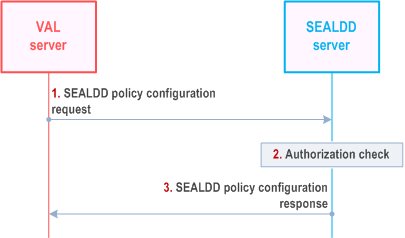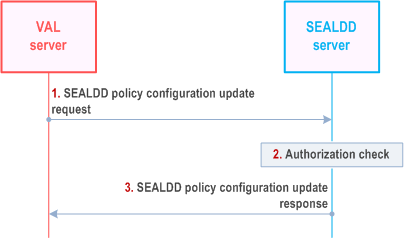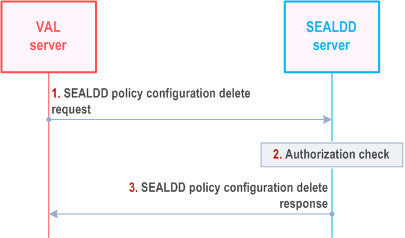Content for TS 23.433 Word version: 19.0.0
0…
4…
7…
8…
9.2…
9.2.2.3…
9.2.3…
9.2.4…
9.3…
9.3.2.2…
9.3.3…
9.3.4…
9.4…
9.5…
9.5.3…
9.5.4…
9.6…
9.7…
9.7.3…
9.7.4…
9.8…
9.9…
9.10…
A…
C…
9.10 SEALDD policy configuration
9.10.1 General
9.10.2 Procedures
9.10.2.1 SEALDD policy configuration
9.10.2.2 SEALDD policy configuration update
9.10.2.3 SEALDD policy configuration delete
9.10.3 Information flows
9.10.3.1 SEALDD policy configuration request
9.10.3.2 SEALDD policy configuration response
9.10.3.3 SEALDD policy configuration update request
9.10.3.4 SEALDD policy configuration update response
9.10.3.5 SEALDD policy configuration delete request
9.10.3.6 SEALDD policy configuration delete response
9.10.4 APIs
9.10.4.1 General
9.10.4.2 Sdd_PolicyConfiguration operation
9.10.4.3 Sdd_PolicyConfiguration update operation
9.10.4.4 Sdd_PolicyConfiguration delete operation
...
...
9.10 SEALDD policy configuration p. 82
9.10.1 General p. 82
The following clauses specify procedures, information flow for SEALDD policy configuration. In clause 9.10, the VAL server is a specific server for configurating SEALDD policy, and is different from the VAL server used for VAL application processing in other clauses.
9.10.2 Procedures p. 82
9.10.2.1 SEALDD policy configuration p. 82
Figure 9.10.2.1-1 illustrates the procedure for SEALDD policy configuration from the VAL server used for SEALDD policy configuration to the SEALDD server.

Step 1.
The VAL server sends the SEALDD policy configuration request to the SEALDD server. The request includes the identifiers of the application traffic (e.g. VAL service ID, VAL server ID), VAL UE identify, and the SEALDD policy.
Step 2.
The SEALDD server performs authorization check to verify whether the VAL server can be accepted/authorized to configure the SEALDD policy.
Step 3.
Upon successful authorization, the SEALDD server stores the SEALDD policy for later use (e.g. for bandwidth control, transmission quality guarantee) and replies to the VAL server with the SEALDD policy configuration response.
9.10.2.2 SEALDD policy configuration update p. 83
Figure 9.10.2.2-1 illustrates the procedure for SEALDD policy configuration update from the VAL server used for SEALDD policy configuration to the SEALDD server.

Step 1.
The VAL server used for SEALDD policy configuration determines that the existing SEALDD policy needs to be updated, the VAL server sends the SEALDD policy configuration update request to the SEALDD server.
Step 2.
The SEALDD server performs authorization check to verify whether the VAL server can be accepted/authorized to update the SEALDD policy configuration.
Step 3.
Upon successful authorization, the SEALDD server updates the SEALDD policy configuration and replies to the VAL server with the SEALDD policy configuration update response.
9.10.2.3 SEALDD policy configuration delete p. 84
Figure 9.10.2.3-1 illustrates the procedure for SEALDD policy configuration delete from the VAL server used for SEALDD policy configuration to the SEALDD server.

Step 1.
The VAL server used for SEALDD policy configuration determines that the existing SEALDD policy needs to be deleted, the VAL server sends the SEALDD policy configuration delete request to the SEALDD server.
Step 2.
The SEALDD server performs authorization check to verify whether the VAL server can be accepted/authorized to delete the SEALDD policy configuration.
Step 3.
Upon successful authorization, the SEALDD server deletes the SEALDD policy configuration and replies to the VAL server with the SEALDD policy configuration update response.
9.10.3 Information flows p. 84
9.10.3.1 SEALDD policy configuration request p. 84
Table 9.10.3.1-1 describes the information flow from the VAL server to the SEALDD server for requesting the SEALDD policy configuration.
| Information element | Status | Description |
|---|---|---|
| Application traffic identifiers | M | Identify of the application traffic (e.g. VAL server ID, VAL service ID). |
| VAL UE identity | O | Identifier of the VAL UE for which SEALDD policy applies. |
| SEALDD policy | M | The SEALDD policy associated with application traffic identifiers, VAL UE identity. |
| > Quality guarantee policy | O
(See NOTE 1)> | Indicates the event (e.g. measurement threshold) to be measured for the quality guarantee. |
| > Quality optimization policy | O
(See NOTE 1)> | Indicates the data transmission adjustment policy (e.g., adjustment need) to be performed in SEALDD layer. |
| > Bandwidth control policy | O
(See NOTE 2) | Indicate the bandwidth control preference, e.g. re-allocating the bandwidth limit between different VAL users, including UL/DL. |
| > Geofence policy | O
(See NOTE 3) | Indicates the geofence policy per VAL service. |
| >> Geofence location | O
(See NOTE 3) | Indicates the geofence location information for the mentioned VAL service. |
| >>Geofence policy action | O
(See NOTE 3) | Indicates the policy action like allowed or blocked. |
| > temporal policy | O
(See NOTE 3) | Indicates the time period for which the sealdd traffic is allowed. |
| > policy expiration time | O
(See NOTE 3) | Indicates the validity of the policy. |
|
NOTE 1:
This IE is used for the SEALDD enabled transmission quality guarantee, as specified in clause 9.9.
NOTE 2:
This IE is used for the SEALDD enabled bandwidth control, as specified in clause 9.8.
NOTE 3:
This IE is used for the SEALDD connection establishment and data delivery, as specified in clause 9.2.
|
||
9.10.3.2 SEALDD policy configuration response p. 85
Table 9.10.3.2-1 describes the information flow from the SEALDD server to the VAL server for responding to the SEALDD policy configuration.
| Information element | Status | Description |
|---|---|---|
| Result | M | Success or failure. |
| > Configuration ID | O
(See NOTE) | Identifier of the SEALDD policy configuration. |
| > Expiration time | O
(See NOTE) | Indicates the expiration time of the configured SEALDD policy |
|
NOTE:
These IEs are used for the successful case for SEALDD policy configuration request.
|
||
9.10.3.3 SEALDD policy configuration update request p. 85
Table 9.10.3.3-1 describes the information flow from the VAL server to the SEALDD server for requesting the SEALDD policy configuration update.
| Information element | Status | Description |
|---|---|---|
| Configuration ID | M | Identifier of the SEALDD policy configuration. |
| Updated SEALDD policy | O | The updated SEALDD policy as described in Table 9.10.3.1-1. |
9.10.3.4 SEALDD policy configuration update response p. 86
Table 9.10.3.4-1 describes the information flow from the SEALDD server to the VAL server for responding to the SEALDD policy configuration update.
| Information element | Status | Description |
|---|---|---|
| Result | M | Success or failure. |
| > Expiration time | O
(See NOTE) | Indicates the expiration time of the configured SEALDD policy |
|
NOTE:
This IEs is used for the successful case for SEALDD policy configuration update request.
|
||
9.10.3.5 SEALDD policy configuration delete request p. 86
Table 9.10.3.5-1 describes the information flow from the VAL server to the SEALDD server for requesting the SEALDD policy configuration delete.
| Information element | Status | Description |
|---|---|---|
| Configuration ID | M | Identifier of the SEALDD policy configuration. |
9.10.3.6 SEALDD policy configuration delete response p. 86
Table 9.10.3.6-1 describes the information flow from the SEALDD server to the VAL server for responding to the SEALDD policy configuration delete.
| Information element | Status | Description |
|---|---|---|
| Result | M | Success or failure. |
9.10.4 APIs p. 86
9.10.4.1 General p. 86
Table 9.10.4.1-1 illustrates the APIs exposed by SEALDD server for SEALDD policy configuration.
| API Name | API Operations | Operation Semantics | Consumer(s) |
|---|---|---|---|
| Sdd_ | Request | Request/Response | VAL server |
| Update | |||
| Delete |
9.10.4.2 Sdd_PolicyConfiguration operation p. 86
API operation name:
Sdd_PolicyConfiguration_Request
Description:
The consumer requests for one time for SEALDD policy configuration.
Inputs:
See clause 9.10.3.1.
Outputs:
See clause 9.10.3.2.
See clause 9.10.2.1 for details of usage of this operation.
9.10.4.3 Sdd_PolicyConfiguration update operation p. 87
API operation name:
Sdd_PolicyConfiguration_Update
Description:
The consumer requests for one time for SEALDD policy configuration update.
Inputs:
See clause 9.10.3.3.
Outputs:
See clause 9.10.3.4.
See clause 9.10.2.2 for details of usage of this operation.
9.10.4.4 Sdd_PolicyConfiguration delete operation p. 87
API operation name:
Sdd_PolicyConfiguration_Delete
Description:
The consumer requests for one time for SEALDD policy configuration deletion.
Inputs:
See clause 9.10.3.5.
Outputs:
See clause 9.10.3.6.
See clause 9.10.2.3 for details of the usage of this operation.